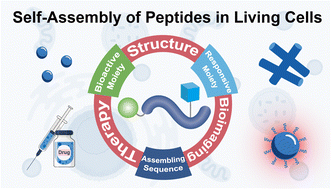Themed collection Stimuli responsive materials for biomedical applications

Dendronization of chitosan to afford unprecedent thermoresponsiveness and tunable microconfinement
Dendronization of chitosan with 3-fold dendritic oligoethylene glycols generates stimuli-responsive and biocompatible dendronized chitosans, which form microconfinement to protect guests or modulate reactions. This confinement can be greatly enhanced through the formation of hydrogels.

J. Mater. Chem. B, 2023,11, 11024-11034
https://doi.org/10.1039/D3TB01803B
Review of NIR-responsive ‘‘Smart’’ carriers for photothermal chemotherapy
This review focuses on the versatile applications of near-infrared (NIR)-responsive smart carriers in biomedical applications, particularly drug delivery and photothermal chemotherapy.

J. Mater. Chem. B, 2024,12, 4785-4808
https://doi.org/10.1039/D3TB03004K
Self-assembly of peptides in living cells for disease theranostics
In situ self-assembly of peptides in living cells regulated by biocompatible stimuli allows for precise creation of well-defined nanostructures and thus offering a versatile strategy for formulation of biomedical agents at pathological lesions.

J. Mater. Chem. B, 2024,12, 4289-4306
https://doi.org/10.1039/D4TB00365A
Mechanistic analysis of viscosity-sensitive fluorescent probes for applications in diabetes detection
This review focuses on fluorescence mechanisms for viscosity responsiveness, highlighting some important probes like coumarin, BODIPY, and xanthene as well as the application of these viscosity-sensitive probes for successful diabetes detection.

J. Mater. Chem. B, 2024,12, 2917-2937
https://doi.org/10.1039/D3TB02697C
Stimuli-responsive peptide hydrogels for biomedical applications
This review summarizes the design strategies and recent research progress of stimuli-responsive peptide hydrogels for biomedical applications.

J. Mater. Chem. B, 2024,12, 1748-1774
https://doi.org/10.1039/D3TB02610H
Smart stimuli-responsive polysaccharide nanohydrogels for drug delivery: a review
Polysaccharides have found extensive utilization as biomaterials in drug delivery systems owing to their remarkable biocompatibility, simple functionalization, and inherent biological properties.

J. Mater. Chem. B, 2023,11, 10538-10565
https://doi.org/10.1039/D3TB01712E
Administration Sequence- and Formulation-dependent Vaccination using Acid-degradable Polymeric Nanoparticles with High Antigen Encapsulation Capability
J. Mater. Chem. B, 2024, Accepted Manuscript
https://doi.org/10.1039/D3TB02834H
Injectable in situ gelling methylcellulose-based hydrogels for bone tissue regeneration
This study contributes to advancing the understanding of methylcellulose-based injectable bone substitutes and their underlying mechanisms of gelation and mineralization.

J. Mater. Chem. B, 2024,12, 4427-4440
https://doi.org/10.1039/D3TB02414H
On-demand release of a selective MMP-13 blocker from an enzyme-responsive injectable hydrogel protects cartilage from degenerative progression in osteoarthritis
Release of BI-4394, a MMP-13 inhibitor, from an enzyme-responsive hydrogel protects cartilage from progressive degeneration in an ACLT rat model.

J. Mater. Chem. B, 2024, Advance Article
https://doi.org/10.1039/D3TB02871B
Star-PCL shape memory polymer (SMP) scaffolds with tunable transition temperatures for enhanced utility
Thermoresponsive shape memory polymers prepared with tunable transition temperatures using star-PCL macromers of varying molecular weights, improving tissue safety for use in applications such as self-fitting bone scaffolds and self-expanding stents.

J. Mater. Chem. B, 2024,12, 3694-3702
https://doi.org/10.1039/D4TB00050A
Minimally designed thermo-magnetic dual responsive soft robots for complex applications
The minimally designed robot (THANOS) showcases excellent control over both thermo- and magnetic responses. The robot performs various tasks including shaping, locomotion, pick-and-place, and release maneuvers of objects using independent triggers.

J. Mater. Chem. B, 2024, Advance Article
https://doi.org/10.1039/D3TB02839A
Hybrid ultrasound and photoacoustic contrast agent designs combining metal phthalocyanines and PBCA microbubbles
The combination of polymeric PBCA microbubbles and highly hydrophobic metal phthalocyanines provides bimodal ultrasound/photoacoustic imaging capabilities based on the high encapsulation efficiencies and tunable optical properties of the latter.

J. Mater. Chem. B, 2024,12, 2511-2522
https://doi.org/10.1039/D3TB02950F
Injectable and self-healable nano-architectured hydrogel for NIR-light responsive chemo- and photothermal bacterial eradication
A stimuli-responsive, injectable, and in situ-forming hydrogel with synergistic, self-healing, and on-demand drug-delivery and antibacterial properties.

J. Mater. Chem. B, 2024,12, 1905-1925
https://doi.org/10.1039/D3TB02693K
Solvent-free synthesis of biostable segmented polyurethane shape memory polymers for biomedical applications
A simple, 1-pot synthesis approach is presented that produces segmented thermoplastic polyurethanes with increased molecular weight and crystallinity, shape memory properties, and the ability to form fibrous scaffolds with high strength.

J. Mater. Chem. B, 2024,12, 1217-1231
https://doi.org/10.1039/D3TB02472E
About this collection
Stimuli-responsive materials exhibit large and abrupt changes in architecture or other properties in response to environmental stimuli. The journey of developing stimuli-responsive materials (organic, inorganic or hybrid) provides ample opportunities for smart materials for applications in drug delivery, biologically-responsive scaffolds, tissue engineering and so on. In recent decades, researchers have explored stimuli-responsive materials to a greater extent because of their non-invasive nature equipped with temporal control over the activation of molecules and/or processes. The development and use of stimuli-responsive materials are highly multidisciplinary and involve research efforts from materials science, chemistry, biomedical engineering, polymer science, biology and physics.
Guest Edited by Prof. N. D. Pradeep Singh (Indian Institute of Technology Kharagpur, India), Dr. Mary Beth Browning Monroe (Syracuse University, United States) and Prof. Yanli Zhao (Nanyang Technological University, Singapore), this themed collection of Journal of Materials Chemistry B is focused on recent developments on stimuli-responsive materials for biomedical applications, including their design, synthesis, characterization, and applications related to biology and medicine.
We hope you enjoy reading the articles in this themed collection!